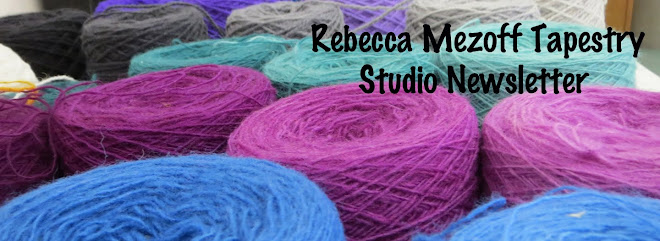A painter can add a bit more red to her blue and make the
purple she wants. A tapestry weaver has no such luxury. We either need to dye
another color or use tapestry techniques to make the colors of our yarns blend optically.
One of the easiest color blending techniques is irregular
hatching. Let's look at how we create this effect.
Most contemporary tapestry weavers use a method of weaving
often called meet and separate, though I've had many students call it "meet and greet". This means that adjacent yarn butterflies or
bobbins are moving toward or away from each other. It looks like this:
I find that this little graphic can be rather helpful for people to remember how this works.Understanding meet and separate is essential to blending colors using irregular hatching. Let's talk more about meet and separate in a short video. (Remember that if you get my blog posts via email, you will have to go to my blog on the internet HERE or on YouTube to view this video.)
Once you understand how meet and separate works, it is a
short jump to understanding irregular hatching.
Meet and separate can be used with butterflies of the same
color. If two different colors are hatched together using the meet and separate
technique, irregular hatching is the result.
Much of what I achieve with color gradation in my own work
is done with irregular hatching. For example, in this piece, Emergence VII, all
the darker shading in the teal band is done this way.
 |
| Rebecca Mezoff, Emergence VII, 45 x 45 inches, hand-dyed wool tapestry |
 |
| Rebecca Mezoff, Emergence VII detail |
In the image above, examples 1 and 2 were done with simple
two-color irregular hatching. Notice that the places the colors meet change
with each sequence and are random. When you use more similar values as in examples
2 and 3, the blending is more subtle. In example 4, the colors were mixed even
further and the points where individual colors meet is lost. This is the point at which you can start to create horizontal color shifts that are seamless.
Let's look at a how to weave irregular hatching in a video. (You can see this video larger on my YouTube channel HERE. Subscribe to my channel while you're there!)
Why would we want to use irregular hatching?
If you are trying to create effects with color blending,
irregular hatching is an important tool. Certainly many tapestry weavers use
sharp delineations between colors in a very graphic style. Others like to
blend colors to achieve more subtle gradations and movement of color. Irregular
hatching is the first of many tapestry techniques that allow this kind of
expression in tapestry weaving.
Below is another example from my own work. Notice that the colors in the five rectangles moves from yellow to red. In each of the rectangles, there were three colors. I hatched those three colors together to make the color change horizontally. There were fifteen colors total in those five blocks, three in each one.
 |
| Rebecca Mezoff, Emergence III |
If you are interested in learning more about the other ways
to create color movement in tapestry, consider my online course, ColorGradation Techniques for Tapestry. If you are just beginning your journey in tapestry weaving, I recommend my beginning online course, Warp and Weft: Learning the Structure of Tapestry.
Information about the blog tour
The Blog Tour Line-Up
December 23rd: Vancouver Yarn
December 30th: Rebecca Mezoff
January 6th: Terry Olson
January 13th: Mirrix Looms
January 20th: Elizabeth Buckley
January 27th: Sarah Swett
This blog tour is in celebration of ATA's upcoming international, unjuried small format exhibition, Tapestry Unlimited, which hangs in Milwaukee next summer. We hope you'll consider participating!
The American Tapestry Alliance is a nonprofit organization that provides programming for tapestry weavers around the world, including exhibitions (like Tapestry Unlimited), both juried and unjuried, in museums, art centers and online, along with exhibition catalogues. They offer workshops, lectures, one-on-one mentoring and online educational articles as well as awards, including scholarships, membership grants, an international student award, and the Award of Excellence. They also put out a quarterly newsletter, monthly eNews & eKudos and CODA, an annual digest. Members benefit from personalized artists pages on the ATA website, online exhibitions, educational articles, access to scholarships and more.
There are PRIZES for participating in the blog tour. Unfortunately, American Tapestry Alliance members are not eligible to win, but if you are not yet a member, consider entering. All you have to do is complete one of the easy social media options in the Rafflecopter box below, one of which is leaving a comment on this blog post. During each of the six weeks of the tour, there are two prizes. One is a free ATA membership and the other is an ATA membership plus a free entry to the unjuried small format tapestry show (tapestries are not due until March, 2016). You can enter every week by following the instructions in the blog post. Many of the bloggers will be using Rafflecopter. Others will choose winners from those who commented on their post.
Some options can be done every day to increase the chances of winning one of the prizes. ATA is a fantastic source of information about tapestry weaving, so don't miss this chance for a free membership!
a Rafflecopter giveaway
And even if you don't want to enter to win, please leave a comment below and share this post with your friends and weaving buddies.
There are PRIZES for participating in the blog tour. Unfortunately, American Tapestry Alliance members are not eligible to win, but if you are not yet a member, consider entering. All you have to do is complete one of the easy social media options in the Rafflecopter box below, one of which is leaving a comment on this blog post. During each of the six weeks of the tour, there are two prizes. One is a free ATA membership and the other is an ATA membership plus a free entry to the unjuried small format tapestry show (tapestries are not due until March, 2016). You can enter every week by following the instructions in the blog post. Many of the bloggers will be using Rafflecopter. Others will choose winners from those who commented on their post.
Some options can be done every day to increase the chances of winning one of the prizes. ATA is a fantastic source of information about tapestry weaving, so don't miss this chance for a free membership!
a Rafflecopter giveaway
And even if you don't want to enter to win, please leave a comment below and share this post with your friends and weaving buddies.






















